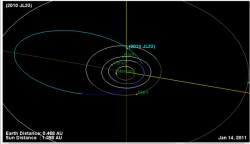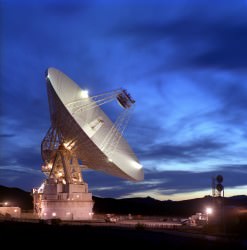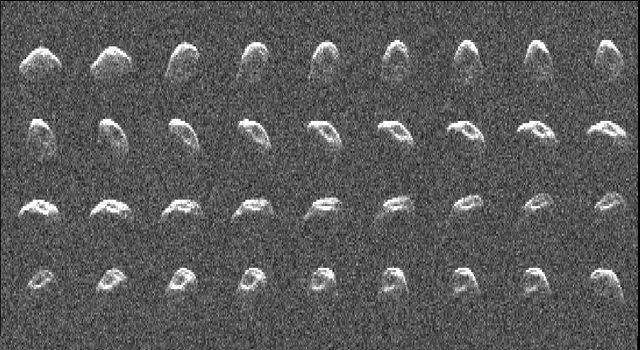[/caption]
Intriguing details about the physical properties and characteristics of a recently discovered asteroid have just been unveiled in amazing images obtained using a large radar dish in California. The radar dish serves as a key component of NASA’s Deep Space Network (DSN). The Near Earth asteroid, dubbed 2010 JL33, was imaged by radar on Dec. 11 and 12, 2010 at NASA’s Goldstone Solar System Radar in California’s Mojave Desert when a close approach to Earth offered an outstanding opportunity for high quality science.
Asteroids studies have taken on significantly increased importance at NASA ever since President Obama decided to cancel the Constellation ‘Return to the Moon’ program and redirect NASA’s next human spaceflight goal to journeying to an Asteroid by around 2025.
Update: Orbital diagram added below
A sequence of 36 amazingly detailed images has been assembled into a short movie (see below) by the science team at NASA’s Jet Propulsion Laboratory (JPL) in Pasadena, Calif. The movie shows about 90 percent of one rotation.
The data gathered by radar revealed that the asteroid measures roughly 1.8 kilometers (1.1 miles) in diameter and rotates once every nine hours.

click to enlage all images
“Asteroid 2010 JL33 approached within 17 Earth-Moon distances [some 7 million km] in December 2010 and offered an outstanding opportunity to study it with radar,” said Lance Benner, a scientist at JPL who studies asteroids.
“To get detailed radar images, an asteroid must be close to Earth,” Benner told me, for Universe Today.
The object was only discovered on May 6 by the Mount Lemmon Survey in Arizona. The radar observations were led by a team headed by JPL scientist Marina Brozovic.
Video Caption: While safely passing Earth, NASA’s Goldstone Solar System Radar captured the rotation of asteroid 2010 JL33 — an irregular, elongated object roughly 1.8 kilometers (1.1) miles wide. The video consists of 36 frames.
“The radar images we got enabled us to estimate the asteroid’s size, rotation period, and to see features on its surface, most notably, the large concavity that appears as a dark region in the collage,” Benner elaborated.
“It was discovered so recently that little else is known about it.”
The object was revealed to be elongated and irregularly shaped.

The 70-meter (230-foot) diameter antenna is the largest, and therefore most sensitive, DSN antenna, and is capable of tracking a spacecraft travelling more than 16 billion kilometers (10 billion miles) from Earth.
The surface of the 70-meter reflector must remain accurate within a fraction of the signal wavelength, meaning that the precision across the 3,850-square-meter (41,400 sq. ft.) surface is maintained within one centimeter (0.4 in.). Credit: NASA
The large concavity is clearly visible in the images and may be an impact crater. It took about 56 seconds for the radio signals from the 70-meter (230-foot) diameter Goldstone radar dish to make the roundtrip from Earth to the asteroid and back to Earth again.
“When we get deeper into our analysis of the data, we will use the images to estimate the three-dimensional shape of the asteroid as well,” Benner added.
Benner belongs to a team that is part of a long-term NASA program to study asteroid physical properties and to improve asteroid orbits using radar telescopes at Goldstone and also at the Arecibo Observatory in Puerto Rico. The 1,000-foot-diameter (305 meters) Arecibo radar dish antenna is operated by the National Science Foundation.
“Each close approach by an asteroid provides an important opportunity to study it, so we try to exploit as many such opportunities as possible to investigate the physical properties of many asteroids. In the bigger picture, this helps us understand how the asteroids formed,” Benner told me.
“Asteroid 2010 JL33 is in an elongated orbit about the Sun. On average, it’s about 2.7 times farther from the Sun than the Earth is, but its distance from the Sun varies from 0.7 to 4.6 times that of the Earth.” That takes the asteroid nearly out to Jupiter at Aphelion. It takes about 4.3 years to complete one orbit around the sun.
But, there’s no need to fret about disaster scenarios. “The probability of impact with Earth is effectively zero for the foreseeable future,” Benner explained.
“On rare occasions it approaches closely to Vesta,” he said. Vesta is the second most massive asteroid and will be visited for the first time by NASA’s Dawn spacecraft later this year.
In addition to the ground based radar imaging, the tiny space rock was investigated by an Earth orbiting telescope.
“This asteroid was also studied by NASA’s Wide-field Infrared Survey Explorer (WISE) spacecraft,” according to Benner. “Our observations will help WISE scientists calibrate their results because we provided an independent means to estimate the size of this object.”
More at this JPL press release. The NASA-JPL Near-Earth Object Program website has an interactive map that allows you to see the asteroid’s position at any time you desire. Go to here
To see the trajectory of any other near-Earth asteroid, go to here
For more information about asteroid radar research, go to here
Information about the Deep Space Network is here


Okay, this is doing my head in. Why do the radar images look like they are lit from one side?
The radio telescope is the illuminant and the detector, so I would expect the thing to appear lit from the direction we are looking. If you had a very narrow band filter you could image the parts that are rotating towards you or away from you by the Doppler shift, but we are almost looking down the axis of rotation.
It’s all here:
http://www.planetary.org/blog/article/00002462/
Radar ‘images’ are NOT images, it’s not a kind of radar flash photography — the resolution would be quite insufficient to see anything than a bright dot.
These are ‘plots’ of signal delay vs Doppler shift, which happen to look like images of the rotating object.
(copy-pasted from my comment on the Planetary blog)
An image, is an image, is an image no matter the method of its derivation.
More radar goodness:
http://www.planetary.org/blog/article/00002742/
Hartley 2 radar images before the flyby, interesting to compare with actual flyby images!
(I don’t remember this being posted on UT, sorry if it was)
This, too:
http://www.fas.org/spp/military/program/track/fgan.pdf
Anybody have an idea on how long would it take assuming the course of it was changed, to impact earth?
Depends on the force acting on it.
Are you planning to hook a rocket to it?
Manu- thanks for adding that very helpful info
I’ve just added the orbital diagram, thanks to JPL – take a look
jhnsn d-s – see diagram and Olaf
good comments from all. thanks
What are the time scales for these pictures? How long between images? What is the rotational period of the asteroid? The video assembled at the JPL site makes it look like it’s rotating quite rapidly, but that just depends on how they set it up from the individual frames.
knealy: The clue is in the article:
“The data gathered by radar revealed that the asteroid measures roughly 1.8 kilometers (1.1 miles) in diameter and rotates once every nine hours.”
Thanks for the link, Manu. A nice explanation, and now I get it. The library of images did mention time was verticaI and frequency shift horizontal, so I might have got there eventually, but the usual sources (Google, Wikipaedia) weren’t much help. And it still looks like a grainy picture of a rotating object lit from the side.
I also note that the very first comment in the link asked why the light was coming from the top. That, I presume, was written after reading the explanation.
I say shoot it with an instrumented impact penetration probe and get a ride to Jupiter!